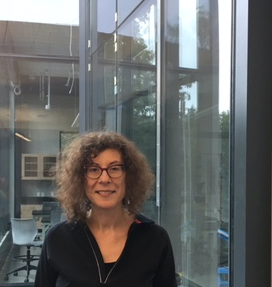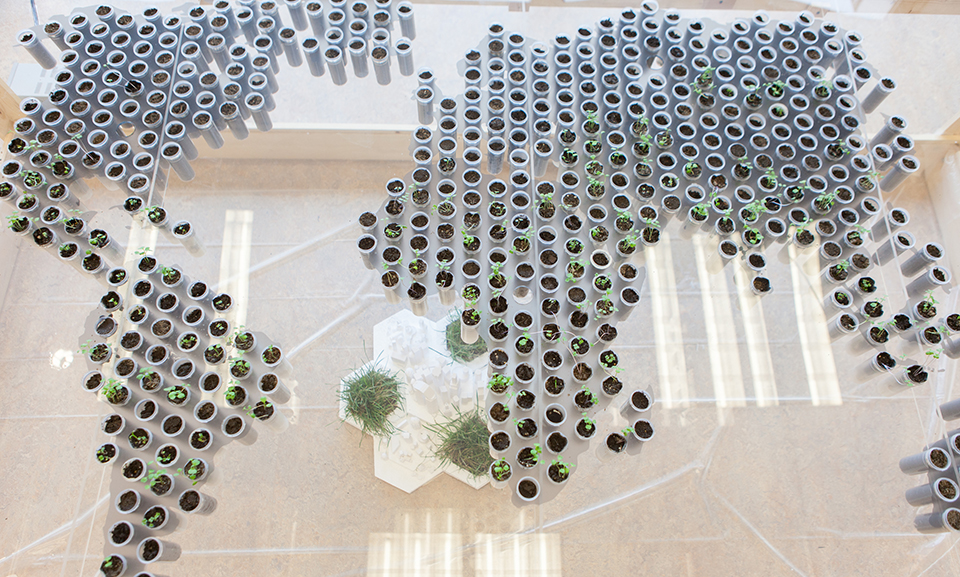Artist Stephanie Rothenberg Thrilled To Be First Roux Scholar
By Tom Porter
She’s sitting behind her desk in Bowdoin’s newest building, the Roux Center for the Environment—a building designed to foster collaboration and creativity in the teaching and study of the environment. Rothenberg, however, is not an environmental scholar: she’s a renowned artist specializing in interactive media installations that most recently incorporate living organisms (or plants), and she’s here as the inaugural Roux Scholar.
Over the next year Rothenberg will be spending a good portion of time away from her regular job as director of graduate studies at SUNY Buffalo’s Department of Art, where she’s also professor of design and emerging practices. As a Roux Scholar, she will not teach courses, but will work with Bowdoin students and faculty in a residency-like program to create an art installation. At the moment, she does not know what that installation will look like or exactly where it will be. “These are early days,” she says, “and the first phase of the project, as with all my work, is to do a lot of research to identify what to me are the important issues. Then I can start narrowing down ideas to decide what the piece will be. Then it’s a question of designing and fabricating the installation.”
No matter what form the installation takes, one thing is for sure, she says: it will be inspired by Maine’s coastal environment and guided by the expertise that’s on tap, both at the Roux Center and via the wider Bowdoin community. “I want to understand the broader marine economy, and I’m hoping this semester will give me the opportunity to connect with alumni working in the industry.” Rothenberg has a busy agenda, which includes trips on fishing boats, as well as visits to clam flats and shellfish farming operations in the area. “I’m also looking forward to working with students and faculty at the Roux Center, where there’s a real interest in looking at art as one platform for dealing with issues like climate change.”

Throughout her career, Rothenberg has developed a reputation for creating interactive works of art designed to make people think about social and economic issues. One of her recent works, The Garden of Virtual Kinship, is described on her website as a “telematic garden whose lifeline is linked to monetary exchanges between the developed and developing world.” The installation features a number of tiny plants, watered by a computerized, mechanical arm connected to the Internet. The amount of sustenance the plants receive is dictated by the level of financial activity—in other words, the amount of money being channeled to developing countries in the form of microloans. Another project, Planthropy, also has a botanical theme, as wifi-enabled planters respond to live Twitter posts about why people donate to charity.
“I’m interested in systems, particularly how technology systems and social media intersect with different economies,” said Rothenberg. “I like to use data in my work, particularly data visualization and real-time data, but the aesthetics are hugely important too, otherwise it’s just dry data. That’s the fun part, making something attractive.”
Regarding the installation project at Bowdoin, her initial thoughts are of some type of interactive work that uses living organisms and also has a data visualization component to reflect man’s impact on the marine environment. “There’s interest in having it here at the Center, either inside or outside the building. It could involve water and marine life, maybe a water-tight, temperature-controlled unit? Maybe an aquaponics system?”
By the end of the academic year, in May, 2019, Rothenberg hopes to have created an interactive artwork that will enable Bowdoin students to participate in the creation process and contribute to the artwork’s longevity. That’s all to be determined, however. Right now, Rothenberg is still at the “anything’s possible” phase, collecting information and ideas. “Creating a piece is a long and difficult process, but it’s exciting to have all this ahead of me.”